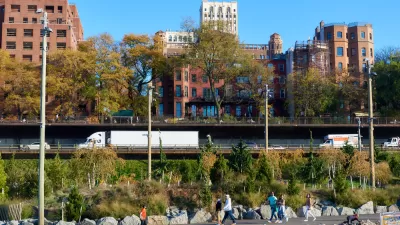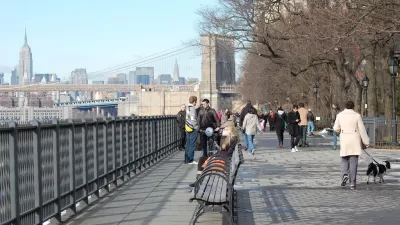The Brooklyn-Queens Expressway needs work, but the various proposals have very different visions about how to tackle the project and what the final outcome will be.

New York’s Brooklyn-Queens Expressway is up for major renovations, and the various proposals on the table could take it in one of a variety of directions. The triple-cantilever portion of the BQE supports the popular Brooklyn Heights Promenade, and the future of the pedestrian walkway is central in many of the debates around the expressway renovation plans.
The Department of Transportation is considering two proposals. The first plan would replace the promenade with a roadway for a period of time while construction work happens below. The second approach would shut down individual lanes, reroute traffic, and close the promenade for a shorter period of time. But the plans are contentious, reports Caroline Spivack:
Both proposals have their pros and cons, and both have garnered fierce opposition. Health experts have raised concerns about air pollution from erecting a highway practically on Brooklyn Heights residents’ doorstep. Preservationists, who say the project may violate decades-old laws that protect the promenade, have threatened legal action if the city moves forward.
Spivack reviews an array of other proposals for the BQE. The Brooklyn Heights Association has an alternative proposal to build a temporary bypass road parallel to the triple cantilever that would leave the promenade in place. City Council Speaker Corey Johnson is leading the charge for considering a teardown of the BQE, but critics say it is not realistic since trucks need access to the boroughs.
Comptroller Scott Stringer's idea for the BQE would not affect the promenade and would add a significant amount of park space. "His plan calls for converting the triple cantilever and the Cobble Hill trench—a depression of the BQE that runs from Congress Street to Hamilton Avenue—into a truck-only highway topped with a nearly two-mile-long 'linear park,'" writes Spivack.
The city has also considered proposals for a tunnel, but this plan is not likely to be pursued due to cost and logistics issues. "No matter what method is used to repair the expressway, one thing is certain: There are no painless solutions," Spivack concludes.
FULL STORY: Transform or tear down? The BQE reconstruction, explained

Alabama: Trump Terminates Settlements for Black Communities Harmed By Raw Sewage
Trump deemed the landmark civil rights agreement “illegal DEI and environmental justice policy.”

Study: Maui’s Plan to Convert Vacation Rentals to Long-Term Housing Could Cause Nearly $1 Billion Economic Loss
The plan would reduce visitor accommodation by 25% resulting in 1,900 jobs lost.

Planetizen Federal Action Tracker
A weekly monitor of how Trump’s orders and actions are impacting planners and planning in America.

This Toronto Suburb Has More Bus Riders Than Columbus, Ohio
Brampton, Ontario used gradual improvements in service to prove that if you build it, they will ride.

Paris Bike Boom Leads to Steep Drop in Air Pollution
The French city’s air quality has improved dramatically in the past 20 years, coinciding with a growth in cycling.

Why Housing Costs More to Build in California Than in Texas
Hard costs like labor and materials combined with ‘soft’ costs such as permitting make building in the San Francisco Bay Area almost three times as costly as in Texas cities.
Urban Design for Planners 1: Software Tools
This six-course series explores essential urban design concepts using open source software and equips planners with the tools they need to participate fully in the urban design process.
Planning for Universal Design
Learn the tools for implementing Universal Design in planning regulations.
Smith Gee Studio
Alamo Area Metropolitan Planning Organization
City of Santa Clarita
Institute for Housing and Urban Development Studies (IHS)
City of Grandview
Harvard GSD Executive Education
Toledo-Lucas County Plan Commissions
Salt Lake City
NYU Wagner Graduate School of Public Service





























